Per Sempre Alfa Magazine Article
Per Sempre Alfa is the offical magazine of the Alfa Romeo Owners Club of Australia (Queensland Division). This is an on-line version of an article originally printed in the magazine and is subject to the Australian Copyright Act. Other than for the purposes of and subject to the conditions prescribed under the Copyright Act, no part of this work may in any form or by any means (electronic, mechanical, photocopying, or otherwise) be reproduced, stored in a retrieval system or transmitted without prior written permission.
Alfa Aero Engines
The production of aero engines formed a relatively brief, but important, chapter in Alfa Romeo's history. Keith Faulkner researched the topic...
In the early 1920s, if you were lucky enough to get your hands on an Alfa Romeo G1, you would discover under its hood a six-cylinder inline engine producing between 35hp (26kw) and 50hp (37kw). A few short years later, if you were after a bit more power, you could take delivery of an Alfa Romeo engine rated at over 780hp (582kw). Unfortunately, this wasn't an engine you could bolt onto your favourite Alfa chassis. It was a nine-cylinder radial air-cooled aero engine.
Alfa Romeo’s involvement in aero engine manufacture is not
that well known, although it does form an important chapter in the
company’s history. As the measure of a true Alfisti is the
keen desire to acquire knowledge of all things Alfa, this short
diversion may be of interest to dedicated Club members. To understand
every twist in the company’s journey from A.L.F.A. to Alfa
Romeo to FIAT S.p.A. is to better comprehend the elusive spirit
that resides behind the cross-and-serpent badge.
It is perhaps fitting to reflect that 2003 marked one hundred years
of sustained powered controlled manned flight. The success of Wilbur
and Orville Wright at Kitty Hawk, North Carolina, on December 17,
1903 needs little discussion. However, while the two brothers may
have been gifted aeronautical designers, they were not engine builders.
Their revolutionary aircraft design needed an equally revolutionary
powerplant. For this they relied on a talented self-taught mechanic
named Charles Taylor.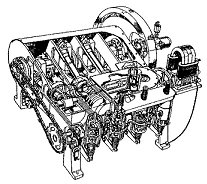
Taylor took the Wright’s requirement for a lightweight, powerful engine and turned it into reality. Using concept drawings furnished by the brothers, Taylor produced a four-cylinder unit weighing 179lb (80.5kg) that generated 12.05hp (9kw) at 1,090rpm, well above the Wright’s target of 8hp (6kw). It used a one-piece aluminium crankcase and water jacket, cast iron pistons and liners, while the crankshaft was machined from a flat slab of high-carbon steel. The engine’s performance was quite impressive, given that contemporary automobile engines giving similar output weighed in at around 600lbs (270kg).
The Wright’s achievements heralded the dawn of a new era of transportation. Aircraft design and manufacture expanded rapidly and aero engines grew in power and sophistication. Just six years after Kitty Hawk, French manufacturers were turning out aero engines such as the 60hp (45kw) water-cooled V8 Antoinette.
The next revolution in aero engine design was the development of radial and rotary types. These did away with heavy cylinder blocks, water jackets and complex crankcases, as well as cumbersome coolant radiators. Instead, they arranged the cylinder jackets in a circle, like the spokes of a wheel, and relied on the airflow over the exposed jackets to cool the engine.
Rotary engines – in which the crankshaft is fixed to the aircraft and engine is fixed to, and rotates with, the propeller – were popular during World War I. These gave way in the 1920s to more conventional static radials – where the engine is fixed to the aircraft frame and the propeller rotates – and more powerful water-cooled inlines and vees.
One of the most influential engines of this period was the Bristol Jupiter, an engine destined to have a strong Alfa Romeo connection (Bristol was the name of the company as well as the English city in which it was headquartered). Designed by Bristol’s Roy Fedden, the Jupiter was a large nine-cylinder radial engine of 1,753 cu in (28.7ltr), producing over 500hp (373kw). By 1932, over 7,100 Jupiters had been produced, many made under foreign licence arrangements. The Pegasus was a further refinement of the Jupiter, eventually developed to produce over 1,000hp (746kw).
Italy had entered the First World War in deep recession. The struggling automobile company Anonima Lombarda Fabbrica Automobili (A.L.F.A.) found itself desperately short of funds and successful businessman Nicola Romeo came to the rescue, acquiring A.L.F.A.’s assets in 1915 and building the company through the war years.
Prior to World War I, Italy had no significant air force, but by the armistice in 1918, 12,000 aircraft and 25,000 aero engines had been produced by Italian industry. Italy had become the fourth aeronautical power in the world, after France, the United Kingdom, and Germany.
The period between World War I and World War II was characterised by great Italian aviation exploits. Among these were the speed record for seaplanes (as yet unbeaten: Macchi, 1934), two air cruises through the Atlantic under Italo Balbo's leadership (South America, 1930; North America, 1934); and the Schneider Cup for seaplanes (won four times by the Italians).
Back on the ground, shortly after World War I, Enzo Ferrari and Vittorio Jano had joined the company now known as Alfa Romeo. Jano had great success on the racetrack with his Alfa P2 and the company’s prestige and reputation grew accordingly. The Italian Government was so impressed with Alfa’s technical achievements, they asked Nicola Romeo if he would manufacture, under license, the British Bristol Jupiter aero engine.
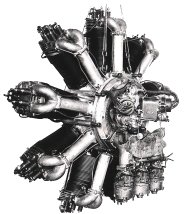 The
choice of the Jupiter was not by chance. In the early 1920s, the
Caproni-Bristol Coanda aircraft had been selected for production
in Italy by the committee controlling a fund which had raised £800,000
to further build the Italian air fleet. A pattern aircraft, built
by Bristol in England, was sent to the Caproni aircraft factory
in Italy and two further aircraft were built there. Unfortunately,
the flight trials were carried out in atrocious weather and the
subsequent poor performance of the aircraft saw the design rejected.
The
choice of the Jupiter was not by chance. In the early 1920s, the
Caproni-Bristol Coanda aircraft had been selected for production
in Italy by the committee controlling a fund which had raised £800,000
to further build the Italian air fleet. A pattern aircraft, built
by Bristol in England, was sent to the Caproni aircraft factory
in Italy and two further aircraft were built there. Unfortunately,
the flight trials were carried out in atrocious weather and the
subsequent poor performance of the aircraft saw the design rejected.
While this particular venture was not successful, it no doubt provided the foundation for Bristol’s relationship with the Italian government and paved the way for the license agreement that saw Alfa Romeo producing the Jupiter/Pegasus engines.
However, despite their success on the racetrack and unquestioned technical superiority, financially the Alfa Romeo company was far from strong. The Italian government’s invitation to build aero engines was not very commercially attractive, but it was an invitation Alfa Romeo could not refuse because of the prestige and honour of doing such valuable government work. Unfortunately, the cost of tooling up for aero engine production only worsened Alfa's fiscal problems.
Alfa Romeo’s initial designation for their licence-built Jupiter was the 126-RC35. Alfa, under Jano’s guidance, also undertook their own refinement of the engine over the next few years, producing the 126-RC34 version and a civil variant designated the RC10.
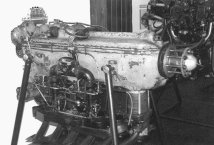 As
the dark clouds of World War II gathered, a significant amount of
Alfa Romeo's production capacity was being taken up with the manufacture
of aircraft engines, including the 200 hp (150kw) 115-II six-cylinder
inverted water-cooled inline and the licence-built British seven-cylinder
Armstrong-Siddley Lynx.
As
the dark clouds of World War II gathered, a significant amount of
Alfa Romeo's production capacity was being taken up with the manufacture
of aircraft engines, including the 200 hp (150kw) 115-II six-cylinder
inverted water-cooled inline and the licence-built British seven-cylinder
Armstrong-Siddley Lynx.
Alfa-powered aircraft of the period included the Caproni 202M of 1936, an all-wood, low-wing monoplane, fitted with the AR 110 six-cylinder inline engine driving a two blade wooden propeller. One such aircraft made a 37-hour flight from Italy to Ethiopia in January 1939. After the war a further small batch was built for military services and many of the type eventually made it onto the civil aircraft register, some remaining in service until the 1970s.
With the outbreak of war in Europe in 1939, Alfa Romeo (now state-owned under the Mussolini regime) ceased building cars altogether. The company's efforts were directed into building aero engines, buses and engines for ships.
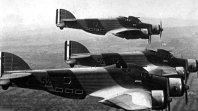 Alfa’s
126-RC34 radial found it’s way into a number of significant
Italian World War II aircraft. One of these was the Savoia-Marchetti
SM79 Sparviero (Sparrowhawk). The SM79 was typical for its time;
a cantilever low-wing monoplane type of mixed construction. Like
the more familiar German Junkers Ju 52, the SM79 was a tri-motor,
powered by three Alfa 126-RC34 engines rated at 780hp (582kw) each.
The Sparviero was based on a civil passenger aircraft and its design
was dated when Italy went to war. Nevertheless, general opinion
holds it as one of the finest torpedo bombers of the war. Because
of it's lumpy silhouette, it was also nicknamed 'Gobbo Maledetto'
or 'Hunchback' by the Italians.
Alfa’s
126-RC34 radial found it’s way into a number of significant
Italian World War II aircraft. One of these was the Savoia-Marchetti
SM79 Sparviero (Sparrowhawk). The SM79 was typical for its time;
a cantilever low-wing monoplane type of mixed construction. Like
the more familiar German Junkers Ju 52, the SM79 was a tri-motor,
powered by three Alfa 126-RC34 engines rated at 780hp (582kw) each.
The Sparviero was based on a civil passenger aircraft and its design
was dated when Italy went to war. Nevertheless, general opinion
holds it as one of the finest torpedo bombers of the war. Because
of it's lumpy silhouette, it was also nicknamed 'Gobbo Maledetto'
or 'Hunchback' by the Italians.
Hostilities obviously limited Alfa Romeo’s access to new engine designs from pre-war British partners Bristol and Armstrong-Siddley, and without sufficient in-house aero engine design experience, the company eventually looked to Italy’s wartime ally, Germany, for suitable engines.
 The
Italian aircraft company Macchi had developed the elegant C202 Folgore
(Lightning) fighter in the late 1930s but because there was no suitable
indigenous inline engine of suitable power, Macchi instead installed
the German-sourced Daimler-Benz DB601 twelve-cylinder inverted-V
liquid-cooled engine. This engine had a capacity of 2075 cu in (34ltr)
and was rated at 1,100 hp (750 kW).
The
Italian aircraft company Macchi had developed the elegant C202 Folgore
(Lightning) fighter in the late 1930s but because there was no suitable
indigenous inline engine of suitable power, Macchi instead installed
the German-sourced Daimler-Benz DB601 twelve-cylinder inverted-V
liquid-cooled engine. This engine had a capacity of 2075 cu in (34ltr)
and was rated at 1,100 hp (750 kW).
The DB601 was the standard powerplant for the deadly German Messerschmitt Bf109 fighter, and was around the same power as the Rolls-Royce Merlins fitted to British Spitfires and Hurricanes. Importantly, the Teutonic expertise in fuel-injection gave DB601-engined aircraft such as the Bf109 the edge over the competition in negative-g (nose-over) manoeuvres; the carburettor-fed Merlin suffered a momentary power loss in such situations.
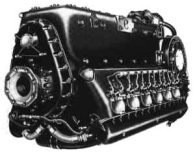 The
result of fitting the DB601 into the Macchi C202 was impressive.
Although it was available too late and in too little numbers to
affect the outcome of Italy’s involvement in the war, the
Macchi C202 proved clearly superior to both the American Curtiss
P-40 and the British Hawker Hurricane. Folgore pilots lauded the
fighter's finger-light handling and superb agility. In fact, the
Italian fighter outperformed all opponents except late marks of
Supermarine Spitfires and North American P-51 Mustangs, aircraft
considered to be at the pinnacle of World War II piston-engined
aircraft design.
The
result of fitting the DB601 into the Macchi C202 was impressive.
Although it was available too late and in too little numbers to
affect the outcome of Italy’s involvement in the war, the
Macchi C202 proved clearly superior to both the American Curtiss
P-40 and the British Hawker Hurricane. Folgore pilots lauded the
fighter's finger-light handling and superb agility. In fact, the
Italian fighter outperformed all opponents except late marks of
Supermarine Spitfires and North American P-51 Mustangs, aircraft
considered to be at the pinnacle of World War II piston-engined
aircraft design.
When supplies of German-built DB601 engines ran out, Alfa Romeo began producing a licensed copy, designated the RA-1000 RC41 Monsonie (Monsoon), but initial production was slow. Although Macchi C202 Folgores outnumbered all other fighter aircraft in the Italian air force, total production was limited by engine availability and amounted to only about 1,500.
The end of the war in Europe saw much of Italy’s manufacturing infrastructure in ruins. Their air force (Regia Aeronautica) was virtually non-existent and Italy’s aeronautical industry had little chance of recovering in the face of massive advances in aviation technology by the British and Americans.
Alfa Romeo eventually re-built their factories and returned to what they did best, building automobiles. It is a testament to the level of sophistication of Alfa’s automotive technology that they could emerge, phoenix-like, from the ashes of World War II and return to competitive automobile production in a relatively short time.
Aero engines produced by Alfa Romeo:
- 110 (six-cylinder inverted inline)
- 115-II (six-cylinder inverted inline)
- 126-RC35 Radial
- 126-RC34 Radial
- RC10 Radial (Civil version of the RC34)
- 128-RC18
- 128-RC21
- 135 RC32
- RA1000
- RA1000 RC41 (License built DB 601)
References:
- A century of Aero Engines – Aeroplane Monthly, January 2003
- Caprioni Rarities – Flightpath, Vol 15 No 2
- The Dream Takes Flight – Aeroplane Monthly, December 2003
- Database: B24 – Aeroplane Monthly, December 2002
Internet sites: